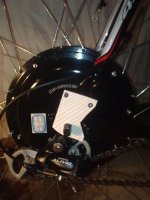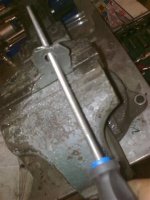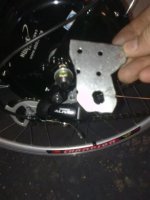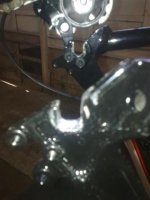minde28383
10 kW
- Joined
- Apr 2, 2010
- Messages
- 700
Hello Gents,
Yesterday I started to put my e-bike together and encountered very disappointing issue with shallow dropouts. Hub's axle does not go into dropouts entirely, only ~70% axle's slides into dropouts. I have found that some lads do some filling to deepen dropouts, also puts some torque arm which supposedly would stop axle from spinning in case dropouts would go crack. I don't mind to do some filling but not sure how it will affect frame's strength and reliability. Have you encountered such dropout issue and managed solve it and how? Or maybe you even had issue with Trek's 4300 dropouts.
yes, pics quality is not good, only cheap camera was on hand.
Yesterday I started to put my e-bike together and encountered very disappointing issue with shallow dropouts. Hub's axle does not go into dropouts entirely, only ~70% axle's slides into dropouts. I have found that some lads do some filling to deepen dropouts, also puts some torque arm which supposedly would stop axle from spinning in case dropouts would go crack. I don't mind to do some filling but not sure how it will affect frame's strength and reliability. Have you encountered such dropout issue and managed solve it and how? Or maybe you even had issue with Trek's 4300 dropouts.
yes, pics quality is not good, only cheap camera was on hand.


![Atvaizd0197 [640x480].jpg](/sphere/data/attachments/23/23610-be55c25b3bfae545fd31ba0eac8fc86d.jpg)
![Atvaizd0200 [640x480].jpg](/sphere/data/attachments/23/23611-d64609aa461165a3dddc6df801eadb41.jpg)
![Atvaizd0203 [640x480].jpg](/sphere/data/attachments/23/23612-ec606b9b96bd4a134b66654f46617892.jpg)
![Atvaizd0198 [640x480].jpg](/sphere/data/attachments/23/23613-7ca77985e4815ee20b4637b88be73487.jpg)
![Atvaizd0199 [640x480].jpg](/sphere/data/attachments/23/23614-ece3d379f65eb72b913995ad24606487.jpg)
![Atvaizd0202 [640x480].jpg](/sphere/data/attachments/23/23615-b8448f7262a00cfb77cb62f1cdb82507.jpg)




